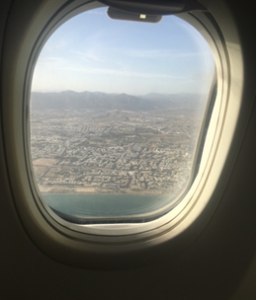Difference between revisions of "Lavatia Khojas"
| Line 6: | Line 6: | ||
As we came to land at Muscat airport, our guide, a Muscati scholar originally from Iraq and now working in Holland, had joined us for the Khoja Studies Conference in Mumbai, pointed to Matrah, situated a few miles west of Muscat. Set amid volcanic hills, Matrah was the hub of business and is the location of Sur al-Lavatia – an area as mysterious as the people who used to live there and still own the houses there. Located at the heart of one of Oman’s major tourist spots, Matrah is flanked by a corniche walkway where cruise ships offload hundreds of tourists. | As we came to land at Muscat airport, our guide, a Muscati scholar originally from Iraq and now working in Holland, had joined us for the Khoja Studies Conference in Mumbai, pointed to Matrah, situated a few miles west of Muscat. Set amid volcanic hills, Matrah was the hub of business and is the location of Sur al-Lavatia – an area as mysterious as the people who used to live there and still own the houses there. Located at the heart of one of Oman’s major tourist spots, Matrah is flanked by a corniche walkway where cruise ships offload hundreds of tourists. | ||
| + | |||
| + | |||
| + | |||
| Line 26: | Line 29: | ||
Nestled just behind the bustling souq, one of the oldest in the area, and the waterfront is Sur al-Lavatia (sur in Arabic means a fortified enclosure). For many years, this picturesque district was closed to all except members of the Lavatia community. | Nestled just behind the bustling souq, one of the oldest in the area, and the waterfront is Sur al-Lavatia (sur in Arabic means a fortified enclosure). For many years, this picturesque district was closed to all except members of the Lavatia community. | ||
| + | |||
| + | |||
| + | |||
| + | |||
| + | |||
| + | |||
| + | |||
| + | |||
| + | |||
| + | |||
| + | |||
Revision as of 09:12, 28 May 2019
The Lavatia of Oman: Arabs or Khojas – An Intriguing Paradigm of Binary Identity
Hasnain Walji
As we came to land at Muscat airport, our guide, a Muscati scholar originally from Iraq and now working in Holland, had joined us for the Khoja Studies Conference in Mumbai, pointed to Matrah, situated a few miles west of Muscat. Set amid volcanic hills, Matrah was the hub of business and is the location of Sur al-Lavatia – an area as mysterious as the people who used to live there and still own the houses there. Located at the heart of one of Oman’s major tourist spots, Matrah is flanked by a corniche walkway where cruise ships offload hundreds of tourists.
Nestled just behind the bustling souq, one of the oldest in the area, and the waterfront is Sur al-Lavatia (sur in Arabic means a fortified enclosure). For many years, this picturesque district was closed to all except members of the Lavatia community.
Salma Damluji, in her book The Architecture of Oman writes ‘The Portuguese are thought to have originally founded the settlement, since a Portuguese garrison is recorded there in the 17th century. It is possible that after the Portuguese were expelled the area was given over by the Sultan to the Muscati Khojas then known as Hyderabadis.’
Today, though not officially closed, this walled quarter is discreetly guarded and continues to intrigue tourists looking to get a glimpse behind the gates and walls
Fortunately for us, our host, a local Lavatia businessman, al-Haj Jawad Fajwani, gave us a rare guided tour of the mansions behind those walls. Although most residents have now moved to posher neighborhoods of Muscat, the houses are still owned by the original families, who converge there for Muharram commemorations as well as other epochal dates in the Shia Calendar.



